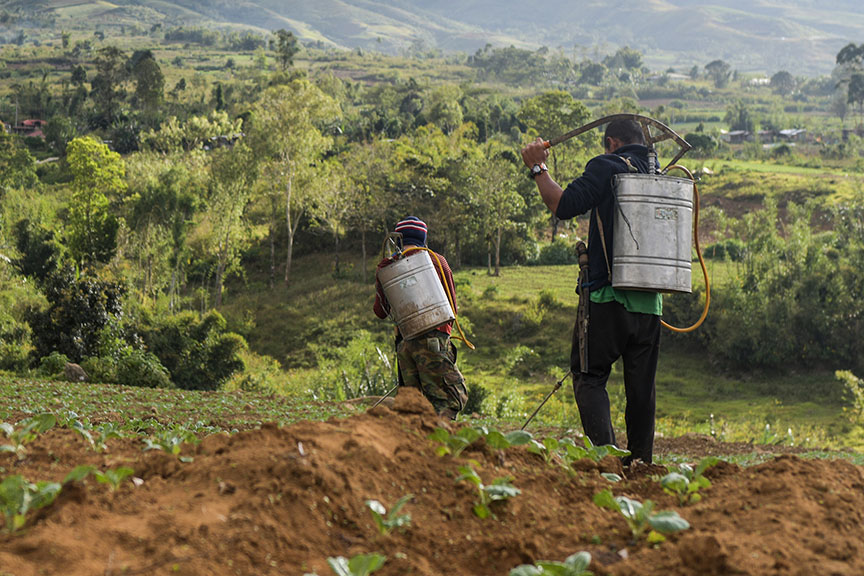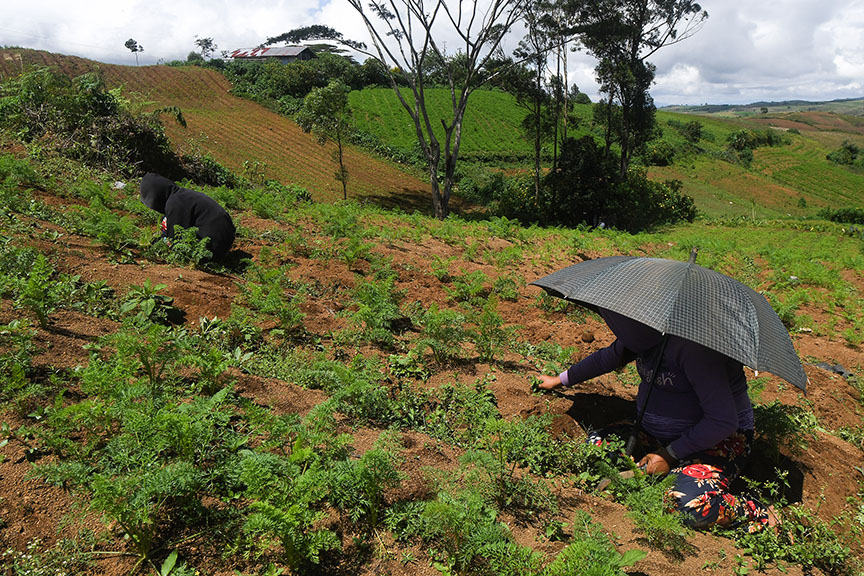TALAKAG, Bukidnon (MindaNews / 24 Nov) – Adolfo Santos, a farmer of the Talaandig tribe, has been growing vegetables in the slopes of Miarayon at the foot of Mt. Kalatungan for decades now.
 Talaandig farmer Adolfo Santos tills his farm in Barangay Miarayon, Talakag town in Bukidnon. MindaNews photo by FROILAN GALLARDO
Talaandig farmer Adolfo Santos tills his farm in Barangay Miarayon, Talakag town in Bukidnon. MindaNews photo by FROILAN GALLARDO
This municipality – particularly Barangay Miarayon – after all, has been known as the vegetable-growing capital of Northern Mindanao.
But there’s a noticeable difference in Santos’s farming methods these days, compared to the days of his youth – the 48-year-old farmer now uses fertilizers.
Miarayon farmers are beset with growing problems of decreasing yields, dependence to chemicals, and incursions of lowlanders to the Talaandig ancestral land.
During a visit to his farm towards the end of October, Santos was carefully guiding his cow as he plowed the green field in circles.
Santos was lucky that it rained the past week, softening the fields of Miarayon.
He would finish plowing the one-hectare land by the day’s end. The next day, he would be applying chicken manure to the soil. The manure is considered as organic fertilizer that provides nitrogen, phosphorous and potassium to the soil.
 The farmers say the soil in Miarayon used to be so rich that they did not have to use fertilizers in the past. But not anymore. MindaNews photo by FROILAN GALLARDO
The farmers say the soil in Miarayon used to be so rich that they did not have to use fertilizers in the past. But not anymore. MindaNews photo by FROILAN GALLARDO
But what had long been considered good fertilizer is no longer enough these days.
The next day, Santos was scheduled to go to a vegetable trader in Cagayan de Oro City to get a loan not only for him to buy seeds, but chemical fertilizers as well for his carrots to grow well.
“It would have been less expensive to plant carrots had the soil been richer. In the past, we did not use fertilizer,” said the Talaandig who has been farming since his youth.
At least he could save on labor since for the Santoses, farming is a family affair – his wife and three children help till the field.
Ryan Danio, chief of the Miarayon Lapok Lirongan Tinaytayan Talaandig Tribal Association (MILALITTRA), said the entire 8,000-hectare land of the Miarayon area is covered by the Certificate of Ancestral Domain Title (CADT) issued to the Talaandig tribe in 2003.
“After 18 years, it is only now that we are enforcing our tribal laws,” he said during the 18th anniversary celebration of the issuance of the CADT last Oct. 29.
Danio said prior to that, lowlanders, traders and corporations were able to purchase land in their ancestral domain.
The Talaandig tribe is one of the seven ethnic tribes of Bukidnon province. They are mostly found living and farming between two of Mindanao’s highest mountains, Mt. Kalatungan and Mt. Kitanglad, particularly in the municipalities of Talakag and Lantapan. They are the people of the slopes (or “andig” in the vernacular).
 Talaandig women help out in the farm in Barangay Miarayon, Talakag town in Bukidnon. MindaNews photo by FROILAN GALLARDO
Talaandig women help out in the farm in Barangay Miarayon, Talakag town in Bukidnon. MindaNews photo by FROILAN GALLARDO
The ancestral domain of MILALITTRA covers five barangays of Talakag town, considered Northern Mindanao’s major vegetable production area.
Talaandig farmers grow potatoes, cauliflowers, carrots, broccoli, Chinese pechay and other vegetables in the rolling slopes.
Danio said Talaandig farmers also grow Arabica coffee. Miarayon coffee, he noted, is considered one of the country’s best.
“Sadly, traders and lowlanders are encroaching on our land. We want to stop them,” he said.
Carlota Madriaga, regional technical director of the Department of Agriculture (DA), said she remembered that Miarayon was so inaccessible back then such that agriculture technicians took a day hiking going there from the nearest accessible road.
“We hiked up and down the mountains on trails and crossed several rivers before we can reach Miarayon,” she said.
Madriaga said the land was so rich during the 1980s that farmers always enjoyed bountiful harvests without the use of fertilizers and other chemicals.
 For the Talaandigs, of Miarayaon in Talakag, Bukidnon, farming is a family affair. MindaNews photo by FROILAN GALLARDO
For the Talaandigs, of Miarayaon in Talakag, Bukidnon, farming is a family affair. MindaNews photo by FROILAN GALLARDO
But deforestation and overuse of the land for agriculture, coupled with the use of chemicals, have affected the soil’s fertility, she pointed out.
Danio said Talaandig farmers, as well as those from the lowlands and even Igorot farmers from the Cordillera in Luzon who migrated to the area 20 or so years ago, have farmed Miarayon’s fields to exhaustion.
“Farmers are now using fertilizers and chemicals even those we consider as very dangerous. They are now heavily dependent on them,” noted Madriaga.
She said the DA is monitoring the chemical and fertilizer content of vegetables produced in Miarayon.
Dharvy Jumanoy, the Talaandig Indigenous People Mandatory Representative, said that harvests from the fields of Miarayon have decreased in the past years.
“A corn farmer used to harvest 50 sacks from a half-hectare lot. Now he would be lucky if he gets 20 sacks if he does not use fertilizers and chemicals,” Jumanoy said.
To help the farmers these days, Madriaga said the DA provided communal irrigation systems and a low-interest financing scheme for the farmers to avail.
She said they also constructed a vegetable terminal in Barangay Miarayon for the convenience of the farmers.
A study conducted by the Xavier University College of Agriculture in 2015 said that 1,648 hectares in Miarayon need to be reforested to bring back the richness of the land and improve the biodiversity.
The study further noted the slopes in Miarayon, if reforested, are important in preventing flood waters from rushing to communities downstream.
On December 16, 2011, floodwaters triggered by tropical storm “Sendong” rolled down from the slopes of Miarayon to Cagayan de Oro and Iligan, killing over a thousand people and destroyed almost P2 billion in infrastructure, agriculture and school buildings, according to a report by the National Disaster Risk Reduction and Management Council said. (Froilan Gallardo / MindaNews, with support from Internews’ Earth Journalism Network and Photojournalists’ Center of the Philippines)
